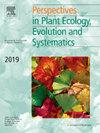Long-term effects of free-ranging cattle and ponies on the soil and vegetation of reseeded grasslands in the New Forest, England
IF 2.9
3区 环境科学与生态学
Q1 ECOLOGY
Perspectives in Plant Ecology Evolution and Systematics
Pub Date : 2025-05-17
DOI:10.1016/j.ppees.2025.125875
引用次数: 0
Abstract
The New Forest, England, includes an extensive area of semi-natural vegetation that is grazed by free-ranging cattle and ponies. Between 1947 and 1958, several areas of nutrient-poor acid grassland were fenced and sown with pasture seed mixtures with the aim of improving the animals’ food resources. After the swards had established, the fences were removed and the leys, known locally as reseeded lawns, have since been grazed continuously. Drawing upon data from previous studies and reports, we investigated changes in the vegetation and soils of these lawns, and in their use by grazing animals, over a period of < 75 years. The sown species, among them Lolium perenne and Trifolium repens, were soon replaced by Agrostis capillaris and rosette-forming forbs such as Hypochoeris radicata and Leontodon autumnalis. After about 1996, the cover of Danthonia decumbens and various Carex spp. increased, and heathland species, especially Calluna vulgaris, began to encroach onto the lawns. This floristic succession was associated with declining productivity and lower nutritional quality of herbage, and reduced use of lawns by livestock. We present various lines of evidence indicating that the main driver of these changes was declining soil phosphorus (P), caused in large part by its export from lawns in excreta and in the bodies of animals leaving the New Forest. We conclude that, through their selective use of habitat, free-ranging livestock can strongly influence vegetation processes at larger spatial scales and may contribute positively to the conservation value of pastoral landscapes.
自由放养的牛和小马对英格兰新森林重新播种草地土壤和植被的长期影响
英格兰的新森林包括一大片半自然植被,自由放养的牛和小马在那里吃草。1947年至1958年间,为了改善动物的食物资源,几个营养贫乏的酸性草地地区被围起来,并播种了牧草混合种子。草皮长好之后,篱笆就被移走了,从那以后,这些被当地人称为“再植草坪”的草地就一直被放牧着。根据以前的研究和报告的数据,我们调查了这些草坪的植被和土壤的变化,以及放牧动物在 75年的时间里对它们的利用。播种种,其中包括黑麦草和三叶草,很快就被毛缕草和莲座形成的草本植物,如根茎草和秋叶草所取代。大约1996年以后,丹东草和各种苔属植物的覆盖面积增加,石南植物以愈伤草为主开始侵占草坪。这种植物区系演替与牧草的生产力下降和营养质量下降以及牲畜对草地的利用减少有关。我们提出了各种各样的证据,表明这些变化的主要驱动因素是土壤磷(P)的下降,这在很大程度上是由草地排泄物和离开新森林的动物体内的磷输出造成的。综上所述,放养牲畜通过对栖息地的选择性利用,在更大的空间尺度上对植被过程产生强烈影响,并可能对田园景观的保护价值做出积极贡献。
本文章由计算机程序翻译,如有差异,请以英文原文为准。
求助全文
约1分钟内获得全文
求助全文
来源期刊
CiteScore
6.50
自引率
0.00%
发文量
28
审稿时长
67 days
期刊介绍:
Perspectives in Plant Ecology, Evolution and Systematics (PPEES) publishes outstanding and thought-provoking articles of general interest to an international readership in the fields of plant ecology, evolution and systematics. Of particular interest are longer, in-depth articles that provide a broad understanding of key topics in the field. There are six issues per year.
The following types of article will be considered:
Full length reviews
Essay reviews
Longer research articles
Meta-analyses
Foundational methodological or empirical papers from large consortia or long-term ecological research sites (LTER).

 求助内容:
求助内容: 应助结果提醒方式:
应助结果提醒方式:


